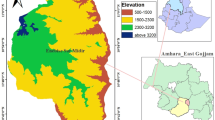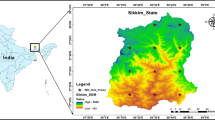Abstract
Extreme precipitation has significant impacts on human society and agriculture development under global climate change as well as severe effects on rice development. However, little research has been done on the characteristics of extreme precipitation in different rice growth stages. Taking the South China region as a case study, the characteristics of extreme daily precipitation in the early rice season (April–July) from 1960 to 2009 were investigated by using percentile method. Results indicated that extreme precipitation threshold increases since the tillering stage, and there is big difference between the first and the rest growth stages. Extreme precipitation is serious in the eastern part than in the western part of South China during the seeding and tillering stage, and reverse since the booting stage. Frequency of extreme precipitation increases in recent decades after the booting stage. Finally, flood risk regions form more easily in the coastal cities and the western part of South China in the 1990s and 2000s since the tillering stage.
Research Highlights
-
Extreme precipitation has significant impact on the rice production in South China region during the early rice period. However, characteristics of extreme precipitation in different rice growth stages are still unclear. The researchers use daily precipitation data (1960–2009) and percentile method to analysis the extreme precipitation distribution in South China region during April–July for early rice season.
-
The researchers found extreme precipitation is serious in South China region since tillering stage, and getting more serious when it comes to the rest of the growth stages. High extreme precipitation centers occur in different region during early rice period. Flood protection and crops planning should focus on different region for different stages. Data analysis also show that extreme precipitation is serious in the eastern part than in the western part of South China during the seeding and tillering stage, and reverse since the booting stage. Frequency of extreme precipitation increases in recent decades and more flood risk region form in the coastal cities. Crop planning and disaster managements in South China during early rice period need for careful consideration of different flood risk region in different stages.












Similar content being viewed by others
References
Abid M, Khan I, Mahmood F, Ashraf U, Imran M and Anjum S A 2015 Response of hybrid rice to various transplanting dates and nitrogen application rates; Philipp. Agric. Scientist 98 98–104.
Beard L R 1943 Statistical analysis in hydrology; Trans. Am. Soc. Civil Eng. Trans. 108 1110–1160.
Bonsal B R, Zhang X, Vincent L A and Hogg W D 2001 Characteristics of daily and extreme temperatures over Canada; J. Climate 14 1959–1976.
Cao F, Gao T, Dan L, Ma Z G, Chen X L, Zou L W and Zhang L X 2019 Synoptic-scale atmospheric circulation anomalies associated with summertime daily precipitation extremes in the middle–lower reaches of the Yangtze River Basin; Clim. Dyn., https://doi.org/10.1007/s00382-019-04687-3.
Ding Y H and Ren G Y 2008 Introduction to Climate Change Science of China; China Meteorological Press, Beijing, 281p.
Huang R H and Du Z C 2010 Evolution characteristics and trend of droughts and floods in China under the background of global warming; Chinese J. Nature 32 187–196 (in Chinese).
IPCC 2014 Climate change 2013: The physical science basis; Working Group I Contribution to the IPCC Fifth Assessment Report of the Intergovernmental Panel on Climate Change; Cambridge, UK, New York, USA, Cambridge University Press.
Jenkinson A F 1977 The Analysis of Meteorological and other Geophysical Extremes; Synoptic Climatology Branch Memo 58 the U.K. Meteorology Office Bracknell, Berkshire United Kingdom, 41p.
Joshi S, Kumar K, Joshi V and Pande B 2014 Rainfall variability and indices of extreme rainfall–analysis and perception study for two stations over central Himalaya; India Nat. Hazards 72 361–374.
Li L P, Zhang K M, Wang C and Zhu J P 2010 Temporal and spatial variations of extreme precipitation in the pre-flood period of South China in recent 40 years; Climate Environ. Res. 15 443–450 (in Chinese).
Li J, Yu R C and Sun W 2013 Duration and seasonality of hourly extreme rainfall in the central eastern China; Acta Meteorol. Sinica 27 99–807.
Lu S J 1990 South China Climate; Meteorological Press, Beijing, pp. 121–132.
Luo Y L and Chen Y 2015 Investigation of the predictability and physical mechanisms of an extreme-rainfall-producing mesoscale convective system along the Meiyu front in East China: An ensemble approach; J. Geophys. Res. Atmos. 120 78–83.
Pan S G, Wen X C, Wang Z M, Ahsraf U, Tian H, Duan M Y, Mo Z M, Fan P S and Tang X R 2017 Benefits of mechanized deep placement of nitrogen fertilizer in direct-seeded rice in South China; Field Crops Res. 203 139–149.
Potty J, Oo S M, Raju P V S and Mohanty U C 2012 Performance of nested WRF model in typhoon simulations over West Pacific and South China Sea; Nat. Hazards 63 1451–1470.
Prasanna V 2016 Heavy precipitation characteristics over India during the summer monsoon season using rain gauge, satellite and reanalysis products; Nat. Hazards 83 253–292.
Wang D H, Xia R D and Liu Y 2011 A preliminary study of the flood-causing rainstorm during the first rainy season in South China in 2008; Acta Meteorol. Sinica 69 137–148 (in Chinese).
Wu L J, Huang R H, He H Y, Shao Y P and Wen Z P 2010 Synoptic characteristics of heavy rainfall events in pre-monsoon season in South China; Adv. Atmos. Sci. 27 315–327.
Wu W, Nie L, Liao Y, Shah F, Cui K H, Wang Q, Lian Y and Huang J L 2013 Toward yield improvement of early-season rice: Other options under double rice-cropping system in central China; Eur. J. Agronomy 45 75–86.
Yang L, Wang D and Peng S 2008 Comparison between MM5 simulations and satellite measurements during Typhoon Chanchu (2006) in the South China Sea; Acta Oceanol. Sinica (English edn.) 31 33–44.
Zeng Z X and Huang W F 2001 The Natural Geographical of Guangdong Province, vol. 2(1), Guangdong People’s Publishing House, Guangzhou, pp. 3–8.
Acknowledgements
This research was supported by the National Youth Natural Science Foundation of China (Grant No. 41705092) and China Guangdong Provincial Natural Science Foundation (Grant No. 2017A030310146).
Author information
Authors and Affiliations
Contributions
Under supervision by Prof. Feihu, Liji Wu made substantial contributions to the conception and design of the work; also performed data analysis and calculations, developed analysis of extreme precipitation distribution in South China region during the early rice period. Li Xie made contribution to the calculations of precipitation data and provided editing and writing assistance.
Corresponding author
Additional information
Communicated by Kavirajan Rajendran
Rights and permissions
About this article
Cite this article
Wu, L., Hu, F. & Xie, L. Characteristics of extreme precipitation in South China during April–July for early rice season. J Earth Syst Sci 129, 189 (2020). https://doi.org/10.1007/s12040-020-01466-1
Received:
Revised:
Accepted:
Published:
DOI: https://doi.org/10.1007/s12040-020-01466-1




